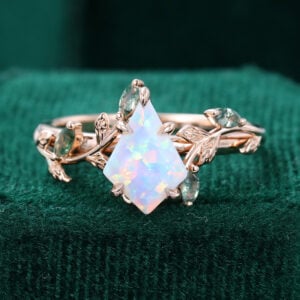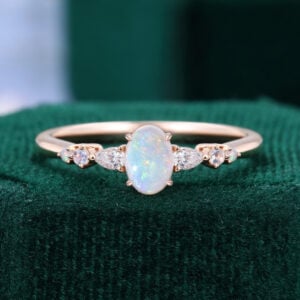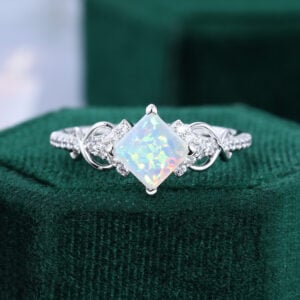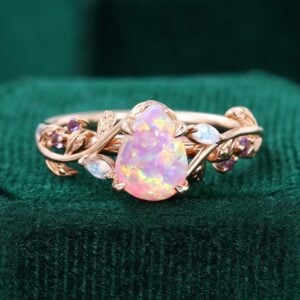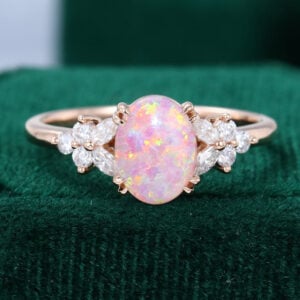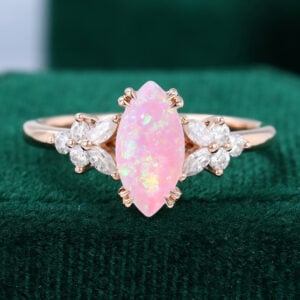Opal is often called the “gem of a thousand colors”—and for good reason. Each stone is like its own universe, with shifting flashes of rainbow light that make no two opals exactly the same. Many people love to showcase these mesmerizing gems in opal rings, pendants, or earrings. But with such variety, many people find themselves asking: What are the different types of opal, and how do I tell them apart?
This complete guide to opal types will walk you through the main varieties of opal, how they’re classified, what determines their value, and how to care for them. By the end, you’ll know which opal best suits your taste, budget, or jewelry style.

Table of Contents
- Overview of Opal Types
- Main Precious Opal Types
- Common Opal Types (Non-Precious Opal)
- Natural Opal vs. Lab & Composite Opal
- What Determines Opal Value
- Care & How to Identify Real Opal
- Opal Types FAQs
Overview of Opal Types
When jewelers or gemologists classify different types of opal, they usually consider these factors:
- Play-of-color → Does the stone show opal’s famous rainbow flashes? (Yes = precious opal, No = common opal).
- Body tone → The background color, ranging from deep black (N1) to milky white (N9).
- Transparency → Is it opaque, translucent, or crystal-clear?
- Formation → Solid opal, boulder opal in host rock, or opal filling natural pores (matrix).
- Origin & treatment → Natural solid, composite (doublet/triplet), or lab-grown.
Together, these dimensions create the diverse family of opal varieties.
Opal Classification System Overview
| Category | Type | Key Features | Value Relevance |
|---|---|---|---|
| Play-of-Color | Precious Opal | Displays play-of-color, internal spectral flashes | Main factor in value |
| Common Opal | No play-of-color, only body color | Lower value | |
| Body Tone | Black Opal | Body tone N1–N4, darkest background | Highest value |
| Dark Opal | N5–N6, medium dark | High value | |
| Light/White Opal | N7–N9, white to pale | Affordable, widely available | |
| Fire Opal | Transparent to translucent, red/orange/yellow body color, sometimes play-of-color | Valued for vivid color | |
| Transparency | Crystal Opal | Transparent to semi-transparent, vivid play-of-color | Very valuable |
| Water Opal | Colorless, transparent to semi-transparent, sometimes faint play-of-color | Rare, delicate beauty | |
| Origin & Structure | Natural Opal | Mined directly, one solid piece | Standard reference |
| Composite Opal | Assembled opal (e.g., doublets, triplets), layered structure | Lower durability & value | |
| Lab Opal | Lab-created, with physical/optical properties similar to natural opal | Affordable alternative |
Main Precious Opal Types
Precious opal is what most people think of when they imagine opals—stones with mesmerizing flashes of color. The following are the main types of natural precious opals, along with their characteristics and sources.
| Type | Appearance | Famous Sources |
|---|---|---|
| Black Opal | Dark body tone (N1–N3) with vibrant, dramatic play-of-color. The rarest and most valuable opal. | Lightning Ridge, Australia |
| White / Light Opal | Pale to milky body tone, with soft pastel-like flashes. | Coober Pedy, Australia; Ethiopia |
| Crystal Opal | Transparent to translucent, with color play that seems suspended inside the stone. | Australia, Ethiopia, Mexico |
| Boulder Opal | Thin opal veins naturally within ironstone, creating striking contrast. | Queensland, Australia |
| Fire Opal | Vivid orange to red body color, sometimes with play-of-color. Even without flashes, its fiery hue is striking. | Mexico, Ethiopia |
✨ Rare types also include Matrix Opal, Moss Opal, and Dendritic Opal, which look like tiny landscapes inside the gem.

Common Opal Types (Non-Precious Opal)
Common opal (also called potch) doesn’t display play-of-color, but it can still be enchanting. These opals typically display a milky-white, translucent to opaque appearance, with a soft, milky sheen known in gemology as opalescence. Popular varieties include:
- Colored Common Opal – Pink, blue, green, lavender, or other natural hues.
- Moss / Dendritic Opal – Opals with tree-like or mossy inclusions.
- Opalized Wood & Fossils – Ancient organic matter replaced by opal, preserving natural textures.
- Hyalite (Opal-AN) – A glassy, clear opal that may glow under UV light.
Natural Opal vs. Lab & Composite Opal
Based on how they are formed, opals can be divided into two main categories: natural opals (formed entirely by nature) and lab-grown or composite opals.
Natural Opal
Natural opals form over millions of years as silica-rich water deposits harden into shimmering gemstones. They are cut and polished, but not otherwise altered. Three main categories exist:
- Solid Opal (Type 1) – One entire piece of opal, such as black, white, or crystal opal.
- Boulder Opal (Type 2) – Opal layers that naturally sit on ironstone host rock.
- Matrix Opal (Type 3) – Opal that fills pores and veins in host rock, creating speckled or web-like patterns.
Lab & Composite Opal
These are man-made or assembled stones that mimic or enhance natural opal. They are beautiful and affordable, but carry different value.
- Doublet Opal – A thin slice of opal glued onto a dark backing to boost contrast.
- Triplet Opal – Like a doublet, but with an added protective clear cap.
- Lab Opal – Lab-grown opals that may look convincing but often show a very regular “snake-skin” pattern.
💡 Are they worth buying? Yes—if you’re on a budget or want everyday wear. Just note that they differ in durability and value retention compared to natural solid opals.
What Determines Opal Value
Not all opals are priced equally. Jewelers evaluate opals based on:
- Play-of-color → Bright, diverse, and evenly spread flashes rank highest. (Color value: red > orange > green > blue).
- Body tone → Darker = stronger contrast and usually higher value.
- Transparency → Crystal-clear or translucent stones are prized.
- Pattern → Rare patterns like harlequin, mosaic, or rolling flash fetch premium prices.
- Brightness Scale (1–5) → Higher brightness means higher value.
- Origin → Lightning Ridge black opals, Ethiopian crystal opals, and Mexican fire opals are especially prized.
- Size & cut → Larger cabochons with good polish hold more value.
- Treatment → Natural solids > doublets/triplets > synthetics.
Care & How to Identify Real Opal

Opal Care Tips
- Mohs hardness: 5.5–6.5 → softer than diamonds. Handle with care.
- Avoid: ultrasonic cleaners, extreme heat, sudden temperature change, harsh chemicals.
- Clean gently with a damp cloth. Store separately.
- Don’t soak doublets/triplets (water may weaken glue).
👉 See our Opal Jewelry Care Guide for more details.
Identifying real vs. lab/composite opal:
- Lab opals often show a highly regular, “snake-skin” pattern.
- Doublets and triplets have visible layering when viewed from the side.
- A clear glassy dome usually means a triplet.
For valuable stones, request a gemological certificate that specifies body tone, transparency, and whether it’s natural or treated.
Opal Types FAQs
Solid black opal, especially from Lightning Ridge, is the most rare and valuable.
Not always. Some fire opals show play-of-color and are classified as precious, but many are valued for their fiery body color alone.
Australia has long been the benchmark, while Ethiopia and Mexico have become well-regarded for their vibrant crystal and fire opals.
They are beautiful but hydrophane, meaning they absorb water. With proper care, they can last a lifetime.
Black opal has a pure dark base, while boulder opal forms in ironstone, showing parts of the host rock.
Typically orange, but it can also be yellow or red, with or without play of color.
Yes, they contain genuine opal, but they’re assembled with backing or a cap to enhance durability and appearance.
Body tone refers to the background color, which defines whether the opal is black, dark, light, or white. Transparency describes whether the stone is transparent, translucent, or opaque. These two factors, together with play-of-color, determine the opal’s visual appeal and market value.
Final Thoughts
From the mysterious depths of black opal to the fiery glow of Mexican fire opal, each opal type has its own magic. Whether you’re drawn to dramatic flashes or soft, pastel hues, there’s an opal variety that can perfectly reflect your personality.
✨ At MollyJewelryUS, we offer a wide variety of opal jewelry designs, from rings to pendant necklaces. We also provide custom services, so you can even create the opal engagement ring of your dreams.


